The LG G5 Review
by Matt Humrick on May 26, 2016 8:00 AM EST- Posted in
- Smartphones
- Snapdragon
- Qualcomm
- LG
- Mobile
- Snapdragon 820
- LG G5
GPU Performance
The LG G5 uses Qualcomm’s latest Adreno 530 GPU. We officially know next to nothing about its low-level architecture; Qualcomm remains tight-lipped about its GPUs, turning them into intriguing black boxes. From the few shreds of information the company has shared over the years, along with our detailed measurements, we know that improving ALU performance has been a top priority for the past few generations. This emphasis has given Adreno GPUs an advantage in games that make heavy use of pixel shading and post-processing, but ARM’s Mali and Imagination’s PowerVR GPUs still held an edge in vertex processing in some configurations. Our initial look at the Adreno 530 showed that it’s a more balanced architecture, with big improvements to vertex processing that alleviate the biggest handicap for past Adreno GPUs.
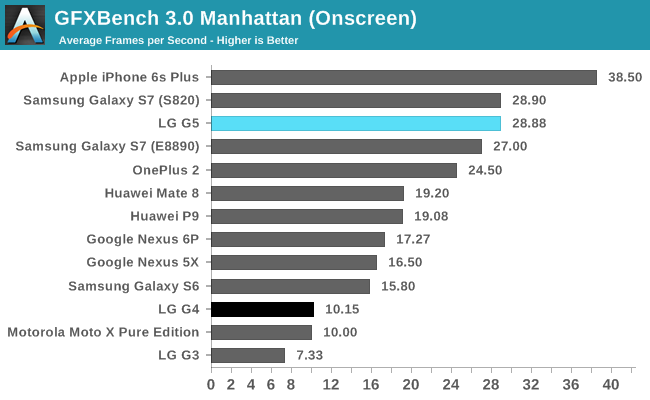
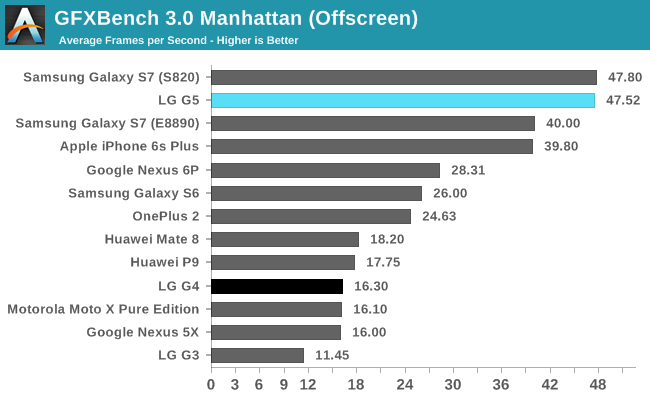
GFXBench 3.0 uses an OpenGL ES 3.0 game engine that stresses lighting and pixel effects. In the offscreen results, Qualcomm’s Adreno 530 leads the pack. The G5 outperforms the previous generation Adreno 430 in the Nexus 6P by 68% and is almost three times faster than the Adreno 418 in the G4.
Even when rendering onscreen at 1440p, the Adreno 530 in the G5 and Galaxy S7 outpace the OnePlus 2’s Adreno 430 rendering at a lower 1080p resolution. The G5 also maintains its nearly 3x advantage over the G4, a significant jump for just one generation.
In the previous section, we routinely saw Huawei’s Mate 8 and P9 near the top of our performance charts; however, their GPU performance is not at the same level. While both use ARM’s latest Mali-T880 GPU, they employ fewer cores (four) that ramp to a high max frequency. The Exynos 7420 SoC in Samsung’s Galaxy S6 uses the previous generation Mali-T760 GPU in an eight core configuration with a slightly lower max clock. With more ALUs and twice as many texture units, the Exynos 7420 offers better GPU performance than the Kirin 950 and 955 in Huawei’s flagships.
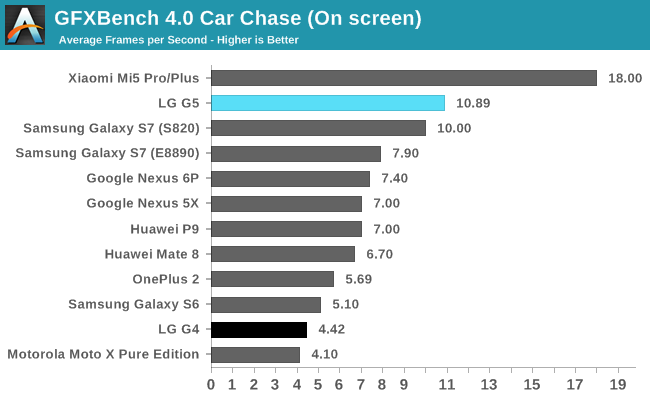
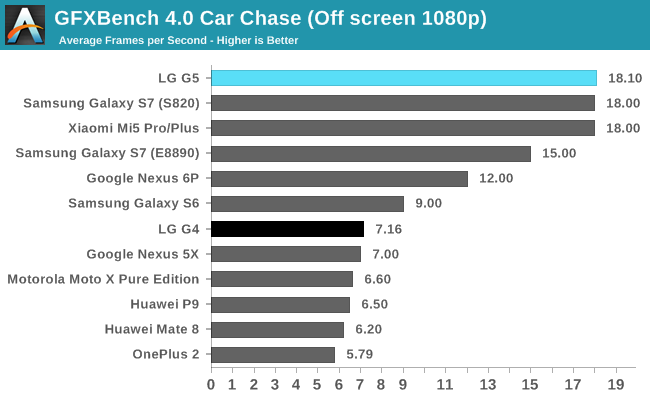
GFXBench 4.0 Car Chase is Kishonti’s latest high-level game engine that uses OpenGL ES 3.1 with Android Extension Pack. Like the earlier Manhattan test, it uses deferred rendering and dynamic lighting, but it also adds visual effects such as HDR tone mapping, motion blur, and bloom using geometry and compute shaders. Perhaps the biggest change is the inclusion of hardware tessellation.
With its heavy reliance on compute shaders, it’s not surprising to see the Adreno 530 GPUs out front once again in this test. The Mali-T880MP12 GPU in the Galaxy S7’s Exynos 8890 SoC comes within 20% of the G5’s Adreno 530, but this margin increases to 38% when running onscreen. The Nexus 6P’s newer graphics driver helps boost performance over the OnePlus 2 by about a factor of two.
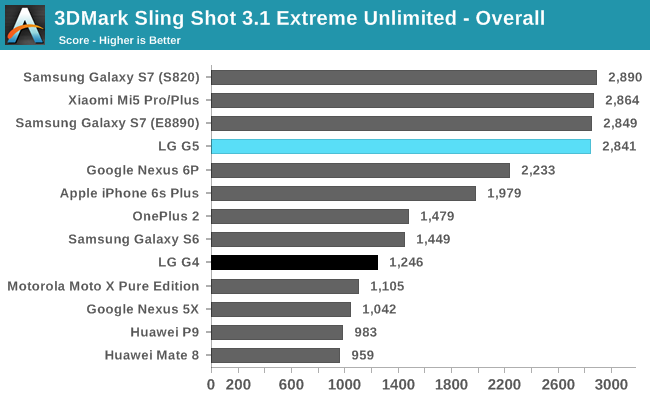
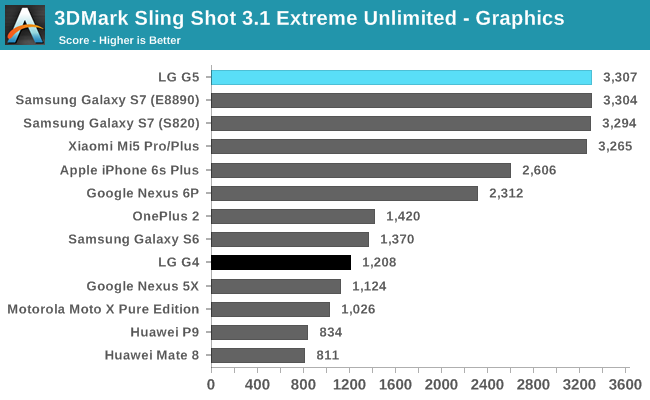
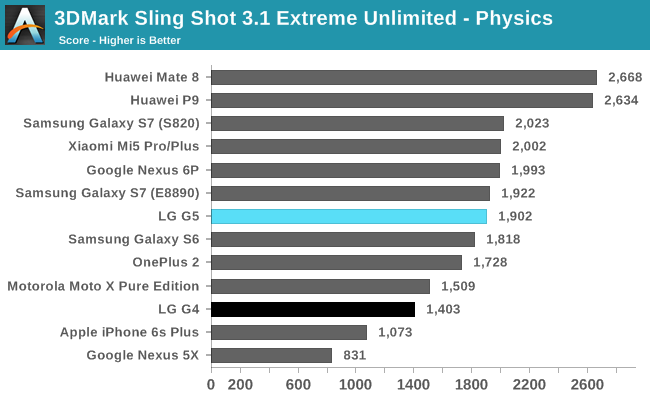
We recently moved from 3DMark’s Ice Storm Unlimited, which uses an OpenGL ES 2.0 graphics engine and renders offscreen at 1280x720, to 3DMark’s newer Sling Shot 3.1 Unlimited, which uses either OpenGL ES 3.1 on Android or Metal on iOS and renders offscreen at a 2560x1440 QHD resolution.
Once again the G5 does well overall thanks to its strong performance in the graphics tests. It’s interesting to see the Exynos 8890 version of the Galaxy S7 perform exactly the same as the Snapdragon 820 phones in the graphics test after trailing in GFXBench 4.0 Car Chase.
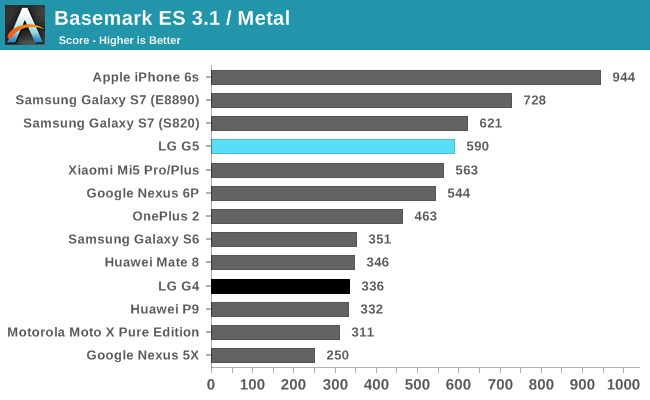

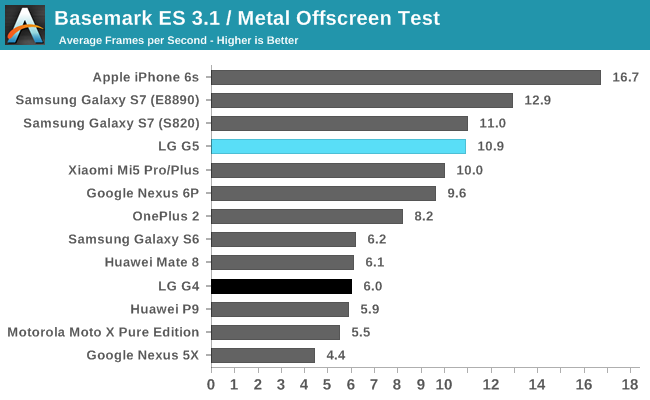
Basemark ES 3.1 is another test that uses either OpenGL ES 3.1 on Android or Metal on iOS. It’s rendering pipeline and feature set are similar to GFXBench 4.0 Car Chase, but it omits tessellation. There’s both on onscreen and offscreen test, with the offscreen test rendering at 1080p.
Here we see the Galaxy S7 and its Exynos 8890 SoC jump ahead of the G5 and the other Snapdragon 820 phones for the first time. Because this is such a complex test with so many graphical features enabled, we cannot gain any insight into particular strengths and weaknesses of each GPU architecture.
Based on these tests it’s clear the G5 offers a significant increase in peak GPU and gaming performance over the G4. It’s Adreno 530 GPU is two to three times faster than the G4’s Adreno 418 and about 50% faster than the Nexus 6P’s Adreno 430 in most tests. The G5 performs better than the Exynos 8890 version of the Galaxy S7 in the two GFXBench tests, but falls a little behind in Basemark ES 3.1. Neither the G3 nor the G4 could match the peak gaming performance of flagship phones in their day, but the G5 is the first in LG’s G Series to get a GPU powerful enough to drive its QHD display. Peak performance is great for benchmarks and bragging rights, but sustained performance, which we’ll examine in the next section, is the real metric that affects the overall gaming experience.










92 Comments
View All Comments
zeeBomb - Sunday, May 29, 2016 - link
This...a million times this. When the G4 introduced Quantum Dot display...I hoped for LG to embark a good feat in innovation. Fast forward to now, LG releases a display we can't even utilize, and is somewhat power hungry? Goodness sake. I think even because of this I moved away from the LG G5 and lost interest in LG devices entirely.Blairdrafting - Friday, May 27, 2016 - link
My problem with the G5 is the erratic antenna signal .... it bounced from 1 to 4 bars even with phone on table right in front of tower... I went to the S7. Same phone just better signalflyingfiddle - Friday, May 27, 2016 - link
Anyone noticing the LG is getting worse and worse on Screen to Body ratio with their flagship phones? (Data from phonearena) G2 76.3%, G3 75.2%, G4 72.5%, and G5 70.2%!! What has LG's designers been smoking? Now with G5 all of sudden proven 5.5 inch screen is too large that they can only fit a 5.3 inch?They have something really unique going for it (removable battery and SD expansion), but they always manage to negate those in some other ways. G3 actually was the best LG I consider, design wise. Unfortunately its construction wasn't great. I recently installed Fulmics 5.2 custom rom (MM based) onto G2 and it flies as fast as G4. G4 was much sturdier, much better constructed, love the leather back, but larger and less economical. Reviewer always say G5 design is a huge departure but if you look at the front the G3 and G5, they are actually very similar. So I don't understand why LG has the shrink the G5's screen so much to fit to that body.
I was super excited watching their launch event but was more and more disappointing after reading review after review and after handling it in-store in person. Just wish my Canadian G4 has unlockable bootloader to allow some decent custom ROM development.
Klug4Pres - Saturday, May 28, 2016 - link
Yes. I am still using a G3, which I find to be a decent size and weight for the size of its screen.I actually think height is the limiting factor for me, and there is always a fair bit of height not covered with screen. Some is needed obviously.
zeeBomb - Sunday, May 29, 2016 - link
Unlockable Bootloader eh... What carrier are you with and which ROM?tuxRoller - Saturday, May 28, 2016 - link
Would you please look into measuring touch latency, please?This is something that no English reviewer seems to be doing even though it is such an integral part of a user's experience.
sireangelus - Saturday, May 28, 2016 - link
Is it just me or the 5x on the benches looks incredibly competitive even in comparison to an s7?refillable - Sunday, May 29, 2016 - link
Sigh... No Offense, but stick to reviewing PC hardware. Just never do these again.Tech_guy - Sunday, May 29, 2016 - link
Why is Snapdragon 820 web performance so horrible versus last years iPhone 6s plus?SydneyBlue120d - Thursday, June 2, 2016 - link
We are at the second generation of SOC with builtin HEVC encoding, and still no signs of any way to use it, do You think we will ever see a smartphone with HEVC encoding enabled? Thanks a lot.